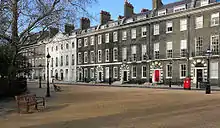Lamb's Conduit Street
Lamb's Conduit Street is a street in Bloomsbury in the West End of London. There are many independent traders along the street. The street is named after William Lambe, in recognition of the £1,500 he gave for the rebuilding of the Holborn Conduit in 1564.[1] (According to The London Encyclopaedia, "The conduit was an Elizabethan dam made in one of the tributaries of the Fleet River and restored in 1577 by William Lamb, who also provided 120 pails for poor women".[2]) The remains of the head of the conduit can be seen on the side of a 1950s building on the corner between Lamb's Conduit Street and Long Yard.

Notable buildings include The Lamb public house, and The People's Supermarket food cooperative.
Notable residents have included John Lind (1737–1781), the barrister, political activist and pamphleteer; John Haslam (1764–1844), the apothecary, physician and medical writer, known for his work on mental illness; and Henry Revell Reynolds (1745–1811) the physician. John Mason Neale (1818–1866), the Church of England clergyman, author, ecclesiologist, hymnologist, and poet, was born at 40 Lamb's Conduit Street.
W. B. Yeats (1865–1939) attended seances at 61 Lamb's Conduit Street, circa 1900.
Virginia Woolf used the architecture of Lamb's Conduit Street to arouse her "historic sense" in the novel Jacob's Room: "The bitter eighteenth century rain rushed down the Kennel."[3][4]
Streets adjoining Lamb's Conduit Street include Rugby Street and Great Ormond Street.
References
- Jordan, W. K. The Charities of London 1480–1660
- Weinreb, Ben and Hibbert, Christopher eds. The London Encyclopaedia. 1983
- Jean Moorcroft Wilson. "Virginia Woolf. Life and London.A biography of place". ISBN 0-393-02615-9.
- https://en.wiktionary.org/wiki/kennel. Etymology 2.
